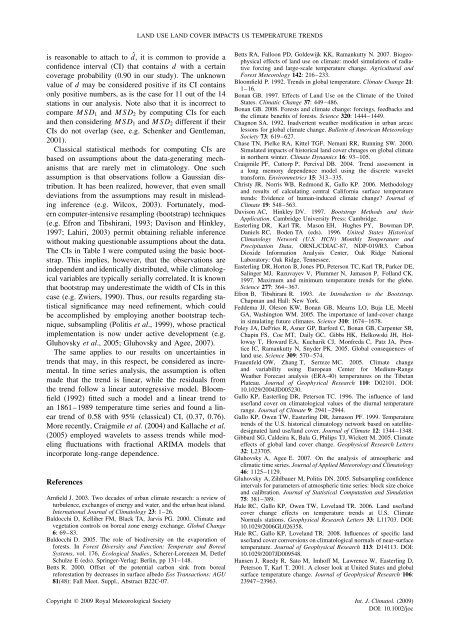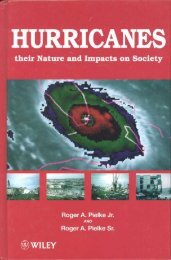Impacts of land use land cover on temperature trends over the ...
Impacts of land use land cover on temperature trends over the ...
Impacts of land use land cover on temperature trends over the ...
You also want an ePaper? Increase the reach of your titles
YUMPU automatically turns print PDFs into web optimized ePapers that Google loves.
LAND USE LAND COVER IMPACTS US TEMPERATURE TRENDS<br />
is reas<strong>on</strong>able to attach to ˆd, it is comm<strong>on</strong> to provide a<br />
c<strong>on</strong>fidence interval (CI) that c<strong>on</strong>tains d with a certain<br />
<str<strong>on</strong>g>c<strong>over</strong></str<strong>on</strong>g>age probability (0.90 in our study). The unknown<br />
value <str<strong>on</strong>g>of</str<strong>on</strong>g> d may be c<strong>on</strong>sidered positive if its CI c<strong>on</strong>tains<br />
<strong>on</strong>ly positive numbers, as is <strong>the</strong> case for 11 out <str<strong>on</strong>g>of</str<strong>on</strong>g> <strong>the</strong> 14<br />
stati<strong>on</strong>s in our analysis. Note also that it is incorrect to<br />
compare MSD1 and MSD2 by computing CIs for each<br />
and <strong>the</strong>n c<strong>on</strong>sidering MSD1 and MSD2 different if <strong>the</strong>ir<br />
CIs do not <strong>over</strong>lap (see, e.g. Schenker and Gentleman,<br />
2001).<br />
Classical statistical methods for computing CIs are<br />
based <strong>on</strong> assumpti<strong>on</strong>s about <strong>the</strong> data-generating mechanisms<br />
that are rarely met in climatology. One such<br />
assumpti<strong>on</strong> is that observati<strong>on</strong>s follow a Gaussian distributi<strong>on</strong>.<br />
It has been realized, however, that even small<br />
deviati<strong>on</strong>s from <strong>the</strong> assumpti<strong>on</strong>s may result in misleading<br />
inference (e.g. Wilcox, 2003). Fortunately, modern<br />
computer-intensive resampling (bootstrap) techniques<br />
(e.g. Efr<strong>on</strong> and Tibshirani, 1993; Davis<strong>on</strong> and Hinkley,<br />
1997; Lahiri, 2003) permit obtaining reliable inference<br />
without making questi<strong>on</strong>able assumpti<strong>on</strong>s about <strong>the</strong> data.<br />
The CIs in Table I were computed using <strong>the</strong> basic bootstrap.<br />
This implies, however, that <strong>the</strong> observati<strong>on</strong>s are<br />
independent and identically distributed, while climatological<br />
variables are typically serially correlated. It is known<br />
that bootstrap may underestimate <strong>the</strong> width <str<strong>on</strong>g>of</str<strong>on</strong>g> CIs in this<br />
case (e.g. Zwiers, 1990). Thus, our results regarding statistical<br />
significance may need refinement, which could<br />
be accomplished by employing ano<strong>the</strong>r bootstrap technique,<br />
subsampling (Politis et al., 1999), whose practical<br />
implementati<strong>on</strong> is now under active development (e.g.<br />
Gluhovsky et al., 2005; Gluhovsky and Agee, 2007).<br />
The same applies to our results <strong>on</strong> uncertainties in<br />
<strong>trends</strong> that may, in this respect, be c<strong>on</strong>sidered as incremental.<br />
In time series analysis, <strong>the</strong> assumpti<strong>on</strong> is <str<strong>on</strong>g>of</str<strong>on</strong>g>ten<br />
made that <strong>the</strong> trend is linear, while <strong>the</strong> residuals from<br />
<strong>the</strong> trend follow a linear autoregressive model. Bloomfield<br />
(1992) fitted such a model and a linear trend to<br />
an 1861–1989 <strong>temperature</strong> time series and found a linear<br />
trend <str<strong>on</strong>g>of</str<strong>on</strong>g> 0.58 with 95% (classical) CI, (0.37, 0.76).<br />
More recently, Craigmile et al. (2004) and Kallache et al.<br />
(2005) employed wavelets to assess <strong>trends</strong> while modeling<br />
fluctuati<strong>on</strong>s with fracti<strong>on</strong>al ARIMA models that<br />
incorporate l<strong>on</strong>g-range dependence.<br />
References<br />
Arnfield J. 2003. Two decades <str<strong>on</strong>g>of</str<strong>on</strong>g> urban climate research: a review <str<strong>on</strong>g>of</str<strong>on</strong>g><br />
turbulence, exchanges <str<strong>on</strong>g>of</str<strong>on</strong>g> energy and water, and <strong>the</strong> urban heat is<str<strong>on</strong>g>land</str<strong>on</strong>g>.<br />
Internati<strong>on</strong>al Journal <str<strong>on</strong>g>of</str<strong>on</strong>g> Climatology 23: 1–26.<br />
Baldocchi D, Kelliher FM, Black TA, Jarvis PG. 2000. Climate and<br />
vegetati<strong>on</strong> c<strong>on</strong>trols <strong>on</strong> boreal z<strong>on</strong>e energy exchange. Global Change<br />
6: 69–83.<br />
Baldocchi D. 2005. The role <str<strong>on</strong>g>of</str<strong>on</strong>g> biodiversity <strong>on</strong> <strong>the</strong> evaporati<strong>on</strong> <str<strong>on</strong>g>of</str<strong>on</strong>g><br />
forests. In Forest Diversity and Functi<strong>on</strong>: Temperate and Boreal<br />
Systems, vol. 176, Ecological Studies, Scherer-Lorenzen M, Detlef<br />
Schulze E (eds). Springer-Verlag: Berlin, pp 131–148.<br />
Betts R. 2000. Offset <str<strong>on</strong>g>of</str<strong>on</strong>g> <strong>the</strong> potential carb<strong>on</strong> sink from boreal<br />
reforestati<strong>on</strong> by decreases in surface albedo Eos Transacti<strong>on</strong>s: AGU<br />
81(48): Fall Meet. Suppl., Abstract B22C-07.<br />
Betts RA, Fallo<strong>on</strong> PD, Goldewijk KK, Ramankutty N. 2007. Biogeophysical<br />
effects <str<strong>on</strong>g>of</str<strong>on</strong>g> <str<strong>on</strong>g>land</str<strong>on</strong>g> <str<strong>on</strong>g>use</str<strong>on</strong>g> <strong>on</strong> climate: model simulati<strong>on</strong>s <str<strong>on</strong>g>of</str<strong>on</strong>g> radiative<br />
forcing and large-scale <strong>temperature</strong> change. Agricultural and<br />
Forest Meteorology 142: 216–233.<br />
Bloomfield P. 1992. Trends in global <strong>temperature</strong>. Climate Change 21:<br />
1–16.<br />
B<strong>on</strong>an GB. 1997. Effects <str<strong>on</strong>g>of</str<strong>on</strong>g> Land Use <strong>on</strong> <strong>the</strong> Climate <str<strong>on</strong>g>of</str<strong>on</strong>g> <strong>the</strong> United<br />
States. Climatic Change 37: 449–486.<br />
B<strong>on</strong>an GB. 2008. Forests and climate change: forcings, feedbacks and<br />
<strong>the</strong> climate benefits <str<strong>on</strong>g>of</str<strong>on</strong>g> forests. Science 320: 1444–1449.<br />
Chagn<strong>on</strong> SA. 1992. Inadvertent wea<strong>the</strong>r modificati<strong>on</strong> in urban areas:<br />
less<strong>on</strong>s for global climate change. Bulletin <str<strong>on</strong>g>of</str<strong>on</strong>g> American Meteorology<br />
Society 73: 619–627.<br />
Chase TN, Pielke RA, Kittel TGF, Nemani RR, Running SW. 2000.<br />
Simulated impacts <str<strong>on</strong>g>of</str<strong>on</strong>g> historical <str<strong>on</strong>g>land</str<strong>on</strong>g> <str<strong>on</strong>g>c<strong>over</strong></str<strong>on</strong>g> chnages <strong>on</strong> global climate<br />
in nor<strong>the</strong>rn winter. Climate Dynamics 16: 93–105.<br />
Craigmile PF, Cuttorp P, Percival DB. 2004. Trend assessment in<br />
a l<strong>on</strong>g memory dependence model using <strong>the</strong> discrete wavelet<br />
transform. Envir<strong>on</strong>metrics 15: 313–335.<br />
Christy JR, Norris WB, Redm<strong>on</strong>d K, Gallo KP. 2006. Methodology<br />
and results <str<strong>on</strong>g>of</str<strong>on</strong>g> calculating central California surface <strong>temperature</strong><br />
<strong>trends</strong>: Evidence <str<strong>on</strong>g>of</str<strong>on</strong>g> human-induced climate change? Journal <str<strong>on</strong>g>of</str<strong>on</strong>g><br />
Climate 19: 548–563.<br />
Davis<strong>on</strong> AC, Hinkley DV. 1997. Bootstrap Methods and <strong>the</strong>ir<br />
Applicati<strong>on</strong>. Cambridge University Press: Cambridge.<br />
Easterling DR, Karl TR, Mas<strong>on</strong> EH, Hughes PY, Bowman DP,<br />
Daniels RC, Boden TA (eds). 1996. United States Historical<br />
Climatology Network (U.S. HCN) M<strong>on</strong>thly Temperature and<br />
Precipitati<strong>on</strong> Data, ORNL/CDIAC-87, NDP-019/R3. Carb<strong>on</strong><br />
Dioxide Informati<strong>on</strong> Analysis Center, Oak Ridge Nati<strong>on</strong>al<br />
Laboratory: Oak Ridge, Tennessee.<br />
Easterling DR, Hort<strong>on</strong> B, J<strong>on</strong>es PD, Peters<strong>on</strong> TC, Karl TR, Parker DE,<br />
Salinger MJ, Razuvayev V, Plummer N, Jamas<strong>on</strong> P, Fol<str<strong>on</strong>g>land</str<strong>on</strong>g> CK.<br />
1997. Maximum and minimum <strong>temperature</strong> <strong>trends</strong> for <strong>the</strong> globe.<br />
Science 277: 364–367.<br />
Efr<strong>on</strong> B, Tibshirani R. 1993. An Introducti<strong>on</strong> to <strong>the</strong> Bootstrap.<br />
Chapman and Hall: New York.<br />
Feddema JJ, Oles<strong>on</strong> KW, B<strong>on</strong>an GB, Mearns LO, Buja LE, Meehl<br />
GA, Washingt<strong>on</strong> WM. 2005. The importance <str<strong>on</strong>g>of</str<strong>on</strong>g> <str<strong>on</strong>g>land</str<strong>on</strong>g>-<str<strong>on</strong>g>c<strong>over</strong></str<strong>on</strong>g> change<br />
in simulating future climates. Science 310: 1674–1678.<br />
Foley JA, DeFries R, Asner GP, Barford C, B<strong>on</strong>an GB, Carpenter SR,<br />
Chapin FS, Coe MT, Daily GC, Gibbs HK, Helkowski JH, Holloway<br />
T, Howard EA, Kucharik CJ, M<strong>on</strong>freda C, Patz JA, Prentice<br />
IC, Ramankutty N, Snyder PK. 2005. Global c<strong>on</strong>sequences <str<strong>on</strong>g>of</str<strong>on</strong>g><br />
<str<strong>on</strong>g>land</str<strong>on</strong>g> <str<strong>on</strong>g>use</str<strong>on</strong>g>. Science 309: 570–574.<br />
Frauenfeld OW, Zhang T, Serreze MC. 2005. Climate change<br />
and variability using European Center for Medium-Range<br />
Wea<strong>the</strong>r Forecast analysis (ERA-40) <strong>temperature</strong>s <strong>on</strong> <strong>the</strong> Tibetan<br />
Plateau. Journal <str<strong>on</strong>g>of</str<strong>on</strong>g> Geophysical Research 110: D02101. DOI:<br />
10.1029/2004JD005230.<br />
Gallo KP, Easterling DR, Peters<strong>on</strong> TC. 1996. The influence <str<strong>on</strong>g>of</str<strong>on</strong>g> <str<strong>on</strong>g>land</str<strong>on</strong>g><br />
<str<strong>on</strong>g>use</str<strong>on</strong>g>/<str<strong>on</strong>g>land</str<strong>on</strong>g> <str<strong>on</strong>g>c<strong>over</strong></str<strong>on</strong>g> <strong>on</strong> climatological values <str<strong>on</strong>g>of</str<strong>on</strong>g> <strong>the</strong> diurnal <strong>temperature</strong><br />
range. Journal <str<strong>on</strong>g>of</str<strong>on</strong>g> Climate 9: 2941–2944.<br />
Gallo KP, Owen TW, Easterling DR, Jamas<strong>on</strong> PF. 1999. Temperature<br />
<strong>trends</strong> <str<strong>on</strong>g>of</str<strong>on</strong>g> <strong>the</strong> U.S. historical climatology network based <strong>on</strong> satellitedesignated<br />
<str<strong>on</strong>g>land</str<strong>on</strong>g> <str<strong>on</strong>g>use</str<strong>on</strong>g>/<str<strong>on</strong>g>land</str<strong>on</strong>g> <str<strong>on</strong>g>c<strong>over</strong></str<strong>on</strong>g>. Journal <str<strong>on</strong>g>of</str<strong>on</strong>g> Climate 12: 1344–1348.<br />
Gibbard SG, Caldeira K, Bala G, Philips TJ, Wickett M. 2005. Climate<br />
effects <str<strong>on</strong>g>of</str<strong>on</strong>g> global <str<strong>on</strong>g>land</str<strong>on</strong>g> <str<strong>on</strong>g>c<strong>over</strong></str<strong>on</strong>g> change. Geophysical Research Letters<br />
32: L23705.<br />
Gluhovsky A, Agee E. 2007. On <strong>the</strong> analysis <str<strong>on</strong>g>of</str<strong>on</strong>g> atmospheric and<br />
climatic time series. Journal <str<strong>on</strong>g>of</str<strong>on</strong>g> Applied Meteorology and Climatology<br />
46: 1125–1129.<br />
Gluhovsky A, Zihlbauer M, Politis DN. 2005. Subsampling c<strong>on</strong>fidence<br />
intervals for parameters <str<strong>on</strong>g>of</str<strong>on</strong>g> atmospheric time series: block size choice<br />
and calibrati<strong>on</strong>. Journal <str<strong>on</strong>g>of</str<strong>on</strong>g> Statistical Computati<strong>on</strong> and Simulati<strong>on</strong><br />
75: 381–389.<br />
Hale RC, Gallo KP, Owen TW, Love<str<strong>on</strong>g>land</str<strong>on</strong>g> TR. 2006. Land <str<strong>on</strong>g>use</str<strong>on</strong>g>/<str<strong>on</strong>g>land</str<strong>on</strong>g><br />
<str<strong>on</strong>g>c<strong>over</strong></str<strong>on</strong>g> change effects <strong>on</strong> <strong>temperature</strong> <strong>trends</strong> at U.S. Climate<br />
Normals stati<strong>on</strong>s. Geophysical Research Letters 33: L11703. DOI:<br />
10.1029/2006GL026358.<br />
Hale RC, Gallo KP, Love<str<strong>on</strong>g>land</str<strong>on</strong>g> TR. 2008. Influences <str<strong>on</strong>g>of</str<strong>on</strong>g> specific <str<strong>on</strong>g>land</str<strong>on</strong>g><br />
<str<strong>on</strong>g>use</str<strong>on</strong>g>/<str<strong>on</strong>g>land</str<strong>on</strong>g> <str<strong>on</strong>g>c<strong>over</strong></str<strong>on</strong>g> c<strong>on</strong>versi<strong>on</strong>s <strong>on</strong> climatological normals <str<strong>on</strong>g>of</str<strong>on</strong>g> near-surface<br />
<strong>temperature</strong>. Journal <str<strong>on</strong>g>of</str<strong>on</strong>g> Geophysical Research 113: D14113. DOI:<br />
10.1029/2007JD009548.<br />
Hansen J, Ruedy R, Sato M, Imh<str<strong>on</strong>g>of</str<strong>on</strong>g>f M, Lawrence W, Easterling D,<br />
Peters<strong>on</strong> T, Karl T. 2001. A closer look at United States and global<br />
surface <strong>temperature</strong> change. Journal <str<strong>on</strong>g>of</str<strong>on</strong>g> Geophysical Research 106:<br />
23947–23963.<br />
Copyright © 2009 Royal Meteorological Society Int. J. Climatol. (2009)<br />
DOI: 10.1002/joc














